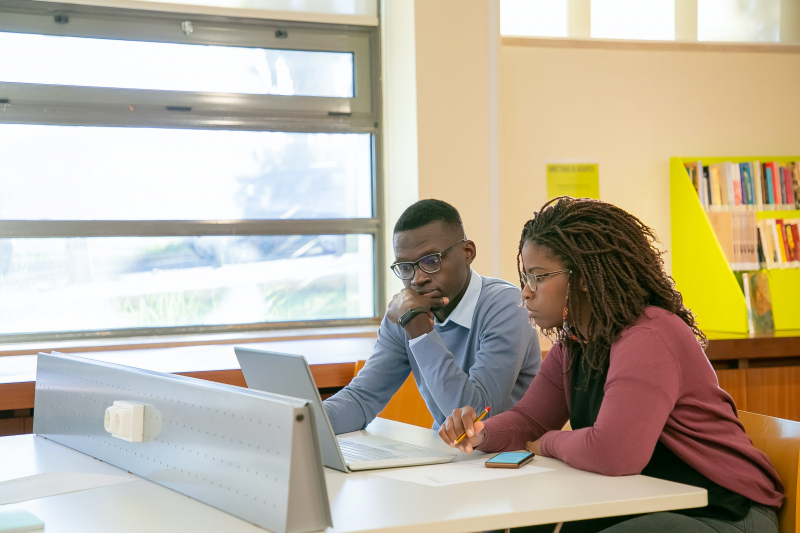Top 10 Cause and Effect Essay Topics for High School and Samples
High school is a critical time for developing writing skills and fostering a deeper understanding of the world. In this article, we present engaging cause and ... read more...effect essay topics designed to spark the imagination of high school students
-
Essay Topic: The Influences and Outcomes of Incorporating M-learning into High School Enviroments.
Answer:
Mobile learning, or M-learning, has emerged as a transformative force in high schools, reshaping the educational landscape. The causes and effects of integrating M-learning into high school environments are intricate, influencing student engagement, accessibility, and overall learning outcomes.
One primary cause of the adoption of M-learning in high schools is the pervasive use of mobile devices among students. The prevalence of smartphones and tablets provides an opportunity to leverage these devices for educational purposes. Additionally, the demand for personalized learning experiences contributes to the integration of M-learning, as it allows students to access content at their own pace and in various formats.
Furthermore, the evolution of educational technology acts as a cause. The development of interactive learning apps, e-books, and educational platforms fosters an environment conducive to M-learning. As schools aim to stay technologically relevant, the adoption of M-learning becomes a natural progression.
Effective M-learning initiatives yield various positive effects. Firstly, it enhances student engagement by providing interactive and dynamic content, catering to diverse learning styles. Secondly, it fosters accessibility, as students can access learning materials anytime and anywhere, reducing geographical and time constraints.
On the flip side, the consequences of inadequate M-learning implementation can be detrimental. Poorly designed applications or insufficient teacher training may lead to disengagement and hinder learning outcomes. Additionally, the digital divide may exacerbate existing educational inequalities if students lack access to the necessary technology.
In closing, the causes and effects of M-learning in high schools underscore its transformative potential in modern education. Driven by the widespread use of mobile devices and the evolution of educational technology, M-learning positively influences student engagement and accessibility. However, careful implementation and consideration of potential challenges are crucial to realizing its full benefits. As high schools navigate the integration of M-learning, understanding these cause-and-effect dynamics becomes paramount for fostering an enriched and equitable learning environment.
Photo by Leeloo Thefirst via pexels 
Photo by Kampus Production via pexels -
Essay Topic: The Importance of Whether A Foreign Language Should Be Taught in High School And Its Impact on Education.
Answer:
Integrating foreign language education into high schools has become a significant pedagogical shift, presenting both causes and effects that shape the academic landscape. The introduction of foreign languages to the high school curriculum reflects a response to global interconnectedness and the recognition of the cognitive benefits associated with bilingualism.
One primary cause is the increasing emphasis on global communication. As the world becomes more interconnected, proficiency in foreign languages equips students with valuable skills for international collaboration and cross-cultural understanding. Additionally, societal demand plays a role, with employers seeking candidates proficient in multiple languages to meet the needs of a diverse and globalized workforce.
Furthermore, educational policies and curricular reforms contribute to the integration of foreign languages. Government initiatives and educational standards often emphasize the importance of language diversity, leading to the inclusion of foreign languages in high school programs.
Effective foreign language education in high schools yields positive effects. Firstly, it enhances cognitive abilities, fostering critical thinking and problem-solving skills. Secondly, it promotes cultural awareness and sensitivity, preparing students to navigate a globalized world with empathy and open-mindedness.However, inadequate foreign language programs may result in negative consequences. Insufficient resources, poorly trained teachers, or limited exposure to authentic language use can hinder students' language acquisition and diminish the intended cognitive benefits.
In summary, the introduction of foreign languages in high schools responds to global demands and educational policies. While enhancing cognitive abilities and cultural awareness, effective implementation is essential. Careful resource allocation ensures the intended positive impacts, emphasizing the importance of linguistic diversity for preparing students in our interconnected world.

Photo by Ivan Samkov via pexels 
Photo by SHVETS production via pexels -
Essay Topic: The Reasons and Impacts of Fostering Teamwork Skills in High School on Students' Future Achievements.
Answer:
Teamwork skills, a crucial aspect of personal and professional development, have found a place in high school curricula, fostering collaborative learning environments. The causes and effects of cultivating teamwork skills in high school extend beyond academic settings, influencing students' future success and adaptability in a team-oriented society.
One significant cause is the recognition of the real-world importance of teamwork. Schools acknowledge the contemporary workplace's emphasis on collaborative projects and seek to prepare students for such environments. Additionally, the evolving nature of careers and industries emphasizes interdisciplinary collaboration, making teamwork skills indispensable for future success.
Furthermore, educational philosophy and pedagogical shifts contribute to the integration of teamwork skills. Modern teaching approaches emphasize the value of collaborative learning, encouraging educators to incorporate group activities and projects into their lesson plans.
The impacts of developing teamwork skills in high school are far-reaching. Firstly, it enhances students' communication and interpersonal abilities, crucial for effective collaboration. Secondly, it nurtures leadership qualities as students learn to navigate group dynamics, fostering a sense of responsibility and initiative.
In contrast, the absence of teamwork education may result in students ill-equipped for collaborative endeavors. In professional settings, the inability to work effectively in teams may hinder career advancement and limit job opportunities.In summary, cultivating teamwork skills in high school is crucial for students' holistic development. Recognizing real-world demands and evolving educational philosophies drive this shift, positively impacting communication, leadership, and interpersonal skills. Embracing teamwork ensures students are well-prepared for the collaborative demands of the contemporary world, enhancing their readiness for future challenges and opportunities.

Photo by Andrea Piacquadio via pexels 
Photo by Andrea Piacquadio via pexels -
Essay Topic: The causes and consequences of bullying problems in high school.
Answer:
Bullying in high schools is a pervasive issue with profound implications for students' well-being and academic environments. The causes and effects of bullying extend beyond individual experiences, influencing the overall school culture and the lifelong trajectory of those involved.
One primary cause of bullying is the perpetuation of aggressive behavior patterns. Students who witness or experience aggression at home or in their communities may replicate these behaviors in the school setting. Additionally, a lack of awareness and education about the consequences of bullying can contribute to its perpetuation, creating an environment where harmful behaviors are normalized.
Moreover, factors like social dynamics and peer pressure may play a role. The inclination to conform or attain social standing can prompt individuals to partake in bullying, seeking affirmation from their peers. Occasionally, deeper problems like low self-esteem or a desire for control may exacerbate tendencies towards bullying.
The repercussions of bullying are extensive and diverse. Firstly, it profoundly affects the mental health of those targeted, leading to conditions such as anxiety, depression, and, in severe cases, contemplation of suicide. Secondly, it alters the overall school climate, establishing a culture of fear and intimidation that obstructs the creation of a positive and supportive learning environment.
Alternatively, individuals involved in bullying may experience adverse outcomes. Partaking in such behaviors could set the stage for a recurring pattern of violence or antisocial conduct during adulthood, influencing various aspects of their personal and professional lives.In summary, addressing the causes and effects of bullying in high schools requires a collective effort. By promoting awareness, fostering a positive school culture, and providing support, we can mitigate the profound impacts on mental health and create a safe environment conducive to the well-being and success of all students.

Photo by Keira Burton via pexels 
Photo by Keira Burton via pexels -
Essay Topic: The reasons and effects of engaging in extracurricular activities in high school.
Answer:
Engaging in extracurricular activities in high school is a dynamic aspect of students' lives, with causes and effects that extend far beyond the confines of the classroom. The reasons behind students participating in these activities are varied and often intertwine with the numerous positive impacts that result from such involvement.
One significant cause is the desire for personal development. Students often join clubs, sports teams, or cultural groups to enhance their skills, broaden their horizons, and discover hidden talents. Additionally, extracurricular activities provide a sense of belonging, fostering social connections and friendships that contribute to a positive high school experience.
Another cause is the pursuit of college and career opportunities. Admissions officers and employers value well-rounded individuals who demonstrate a commitment to diverse interests. Engaging in extracurricular activities showcases qualities such as leadership, teamwork, and time management, all of which are essential in both academic and professional settings.
The effects of participating in extracurricular activities are multifaceted. Firstly, students gain valuable life skills, including effective communication, problem-solving, and organizational abilities, which transcend the specific activity. Secondly, involvement contributes to improved mental health by reducing stress and providing a constructive outlet for students to express themselves.
On the flip side, not participating in extracurricular activities could hinder personal development and overlook potential opportunities. Students exclusively concentrating on academics may lack the interpersonal skills and varied experiences that extracurricular engagement provides, potentially affecting their college admissions or career prospects.In essence, engaging in high school extracurriculars provides holistic benefits, shaping personal development and essential life skills. This involvement extends beyond academics, contributing to improved mental well-being and readiness for future success. Encouraging such engagement ensures a well-rounded education, equipping students for the challenges of both academic and professional spheres.

Photo by Andrea Piacquadio via pexels 
Photo by Andrea Piacquadio via pexels -
Essay Topic: The Grounds and Repercussions of Nutrition Programs Within High School Contexts.
Answer:
Implementing nutrition programs within high school contexts is a deliberate endeavor aimed at fostering healthier lifestyles among students. The causes behind such initiatives and the ensuing effects are multifaceted, contributing to the overall well-being of the student body.
:
One significant cause is the growing awareness of the importance of healthy eating habits. As societies recognize the impact of nutrition on physical and mental well-being, schools are prompted to incorporate programs that promote balanced diets. Additionally, educational policies advocating for holistic development underscore the need for nutritional initiatives in high schools.
Moreover, changes in society aimed at addressing childhood obesity and associated health concerns are crucial. Acknowledging the enduring impacts of inadequate nutrition, governments and schools work together to promote healthier habits from an early age. Legislative actions and school policies harmonize to establish an environment that encourages the adoption of nutritious options.
The effects of school-based nutrition programs are profound. Firstly, students gain better access to balanced meals, positively influencing their overall health. Secondly, such initiatives contribute to enhanced academic performance by ensuring students have the energy and focus necessary for learning.
Conversely, the absence of nutrition programs may result in adverse health outcomes. Students may struggle with issues related to nutrition, leading to fatigue, difficulty concentrating, and potential long-term health concerns. The lack of a structured approach to nutrition could hinder students' physical and cognitive development.
In conclusion, the grounds and repercussions of nutrition programs within high school contexts underscore the importance of cultivating healthy habits early in life. Motivated by a heightened awareness of nutrition's impact and societal shifts towards combating health issues, these initiatives positively influence students' well-being and academic performance. By prioritizing nutritional education and access, high schools contribute to the broader goal of fostering a generation that values and practices lifelong health.
Photo by Pixabay via pexels 
Photo by Mike Jones via pexels -
Essay Topic: The Factors Leading to The Availability of Academic Opportunities and The Resulting Impacts on Shaping Students' Academic Achievements and Future Possibilities.
Answer:The availability of academic opportunities in high school is a critical factor shaping students' educational journeys. The causes driving the provision of such opportunities and the ensuing effects on students are multifaceted, influencing their academic success and future prospects.
A key factor is acknowledging the diverse learning needs of students. Educational institutions recognize that students have different interests and capabilities, leading to the creation of varied academic programs. Furthermore, the desire for a comprehensive education compels schools to offer opportunities in multiple fields, addressing the changing needs of both students and society.
Furthermore, advancements in technology play a role in broadening academic possibilities. Online learning platforms, specialized courses, and virtual resources empower schools to provide a more extensive array of subjects, guaranteeing students access to the latest developments in diverse fields.
The effects of abundant academic opportunities are profound. Firstly, students benefit from a tailored education, allowing them to explore and excel in areas aligned with their passions and strengths. Secondly, a diverse array of academic offerings contributes to a more engaged and motivated student body, fostering a love for learning.
On the flip side, the lack of academic opportunities can restrict students' educational journeys. A shortage of options may make it challenging for students to discover subjects aligning with their interests, potentially resulting in disengagement and a diminished passion for their studies.
In summary, the provision of diverse academic opportunities in high school significantly shapes students' educational experiences. Recognizing diverse learning needs and leveraging technological advancements, schools play a vital role in fostering engagement and preparing students for the multifaceted challenges of higher education and their future careers.

Photo by Keira Burton via pexels 
Photo by Emily Ranquist via pexels -
Essay Topic: Why Do High School Students Work Part-Time And How Does Part-Time Work Affect The Academic Achievement And Time Management Of High School Students?
Answer:
The phenomenon of high school students working part-time is a complex interplay of various factors. Understanding the causes behind their employment decisions and the effects on academic achievement and time management is crucial in navigating the delicate balance between work and education.
One significant cause is financial necessity. Many high school students take on part-time jobs to contribute to their family income or support their personal expenses. The economic realities students face often drive them to seek employment opportunities, balancing the responsibilities of work alongside their academic commitments.
Additionally, the desire for independence motivates students to work. Part-time jobs offer a taste of financial autonomy, enabling them to manage their expenses and gain real-world experiences. This drive for independence becomes a powerful incentive for high school students to enter the workforce.
The effects of part-time work on high school students are diverse. On one hand, employment can instill valuable life skills, including time management, responsibility, and financial literacy. These skills often translate positively into academic endeavors and future professional success.
On the other hand, the academic consequences of part-time work can be negative. Balancing job responsibilities with demanding coursework may induce fatigue and stress, potentially impeding students' academic excellence. Achieving harmony between work and studies presents a nuanced challenge.
In conclusion, the causes and effects of high school students working part-time underscore the intricate relationship between financial necessity, the pursuit of independence, and the impact on academic and time management skills. While part-time work can impart valuable lessons, it poses challenges to academic performance. High schools must recognize this delicate balance, providing support structures to ensure students can manage their responsibilities effectively, fostering both their personal and academic growth.
Photo by Ketut Subiyanto via pexels 
Photo by Marta Dzedyshko via pexels -
Essay Topic: The Causes and Effects of Public Speaking Anxiety among High School Students
Answer:
Public speaking anxiety is a common challenge among high school students, influencing their academic and personal experiences. Understanding the causes behind this anxiety and its effects is crucial for providing effective support to students navigating the complexities of public speaking.
Causes:
One significant cause is the fear of judgment. High school students, often navigating a phase of heightened self-awareness, fear negative evaluation from peers and teachers during public speaking engagements. This fear of scrutiny can be exacerbated by societal expectations and a desire for social approval.
Moreover, lack of experience contributes to public speaking anxiety. Many students have limited exposure to public speaking situations, making it an unfamiliar and intimidating task. The fear of the unknown and the pressure to perform well in such situations can significantly contribute to anxiety.
The effects of public speaking anxiety are multifaceted. Firstly, it can hinder academic performance as students may avoid participating in class presentations or struggle to effectively convey their ideas. Secondly, anxiety in public speaking can negatively impact students' self-esteem, contributing to a cycle of avoidance and heightened anxiety in future speaking engagements.
Conversely, overcoming public speaking anxiety can lead to positive outcomes. Students who develop effective coping strategies and gain experience in public speaking report increased confidence, improved communication skills, and enhanced academic performance.In summary, addressing public speaking anxiety among high school students is crucial for fostering academic and personal growth. By acknowledging the causes, such as fear of judgment and lack of experience, and promoting gradual exposure, schools can empower students to navigate public speaking with confidence, turning this challenge into a valuable skill.

Photo by ThisIsEngineering via pexels 
Photo by Public Speaking Anxiety via pexels -
Essay Topic: The Causes and Effects of Public Speaking Anxiety among High School Students
Answer:
High school yearbooks go beyond photos, embodying memories and experiences. Understanding their creation's intricate causes and diverse effects on students and the school community is crucial. This insight unveils the profound significance of yearbooks as timeless repositories, fostering a sense of continuity and collective identity.
One significant cause is the desire to immortalize high school memories. Yearbooks offer a tangible keepsake, preserving moments, friendships, and achievements. The emotional attachment to these memories propels students and the school community to actively participate in the creation of this cherished publication.
Moreover, yearbooks serve as a means of self-expression. Students, staff, and clubs use yearbook pages to showcase their personalities, accomplishments, and contributions to the school. This desire for self-representation motivates individuals to actively engage in the yearbook creation process.
The effects of yearbooks are profound and far-reaching. Firstly, they foster a sense of belonging and community. The collaborative effort involved in creating yearbooks strengthens the bonds between students and staff, cultivating a shared identity and a feeling of unity within the school.
Secondly, yearbooks become a historical record. They document the evolution of individuals and the school community over the academic year, providing future generations with a glimpse into the past. The preservation of traditions, changes, and milestones enriches the school's legacy.
Lastly, yearbooks contribute to nostalgia and sentimental value. Over the years, students revisit their yearbooks, reliving the moments captured in its pages. The emotional connection fostered by yearbooks extends beyond graduation, creating a lasting link between alumni and their high school experiences.
In conclusion, the causes and effects of yearbooks in high school extend beyond mere documentation. Motivated by the desire to immortalize memories and express individual and collective identities, yearbooks foster community, preserve history, and create enduring sentimental value. This cherished tradition is more than a publication; it's a testament to the vibrant tapestry of high school experiences, connecting generations of students and preserving the essence of each academic year.
Photo by George Pak via pexels 
Photo by olia danilevich via pexels































